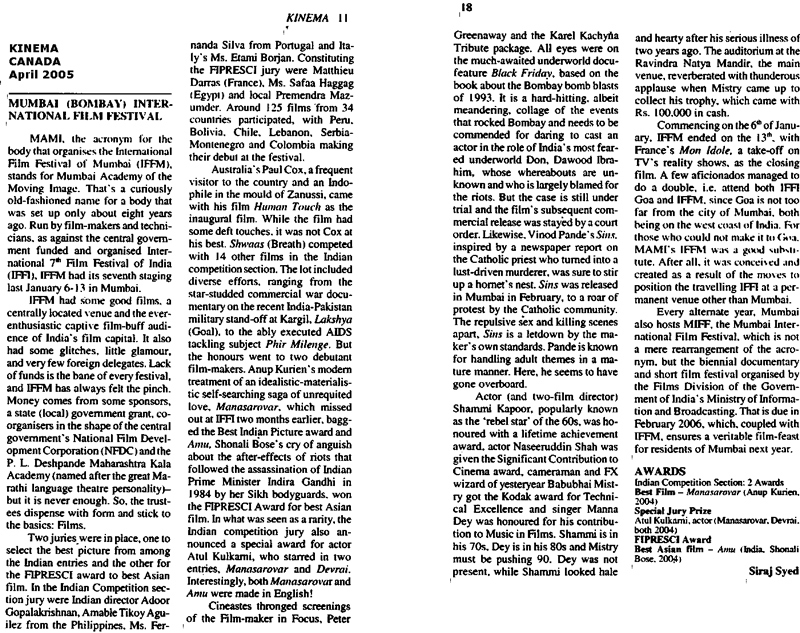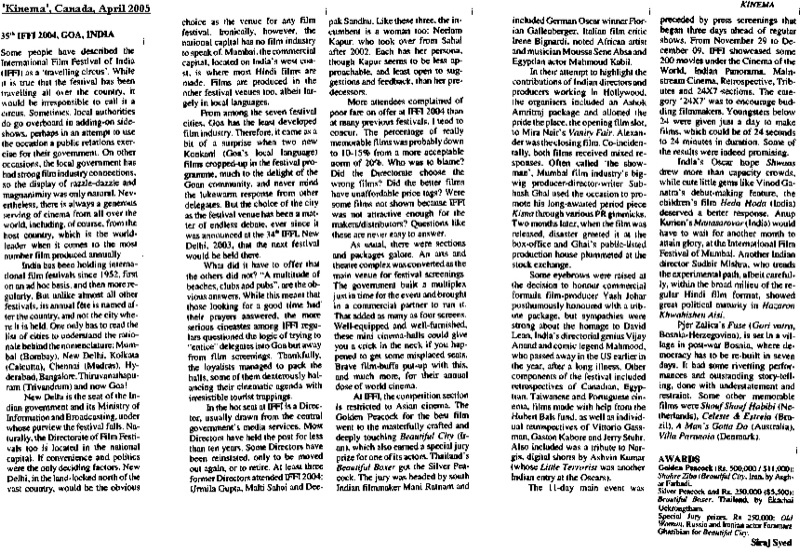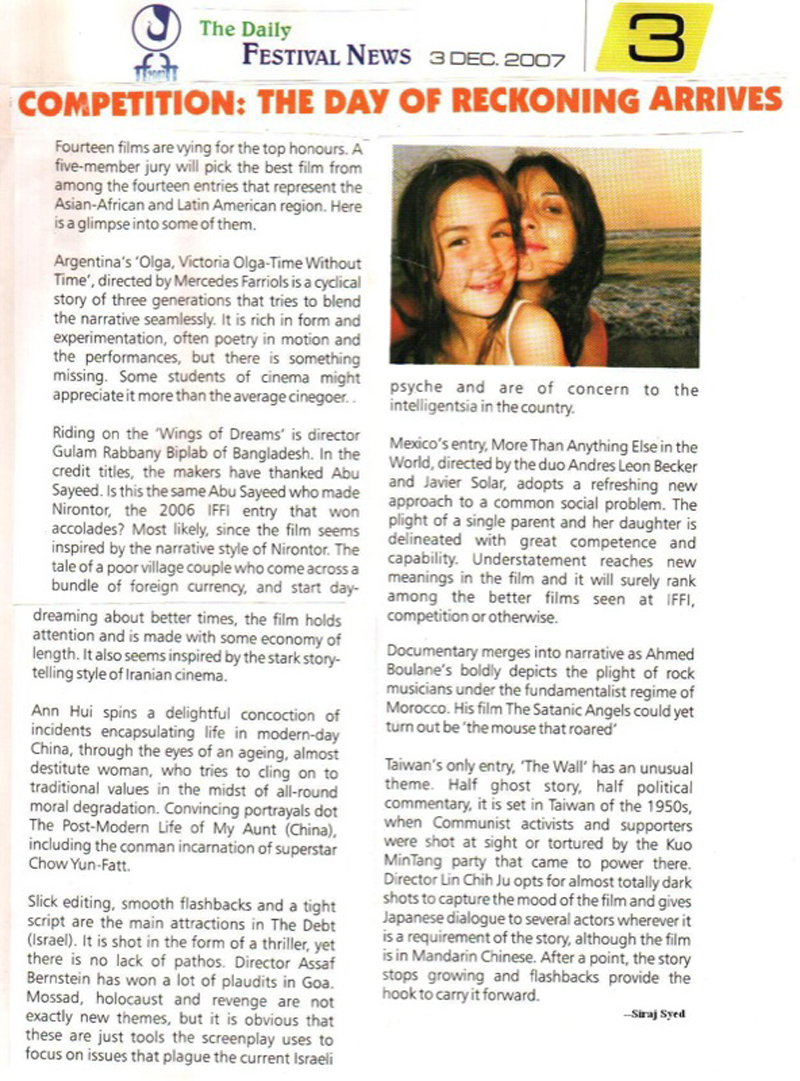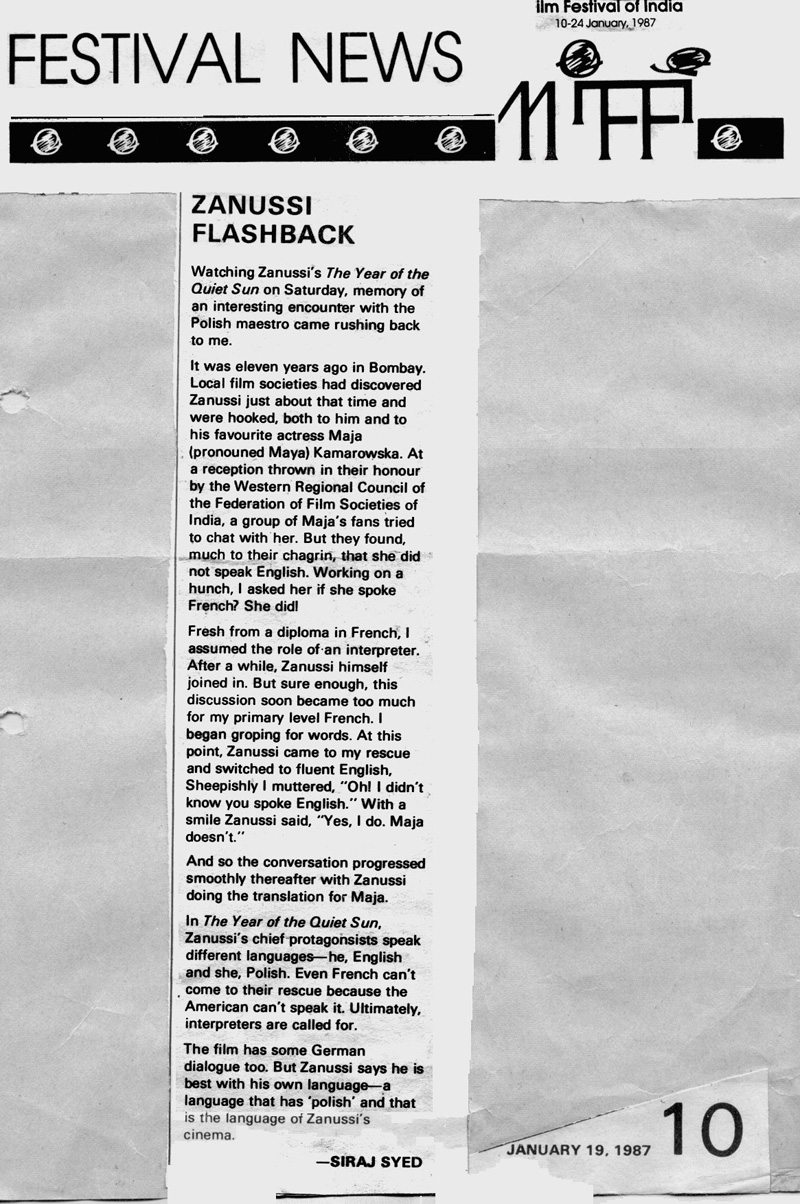|
|
||
|
Pro Tools
FILMFESTIVALS | 24/7 world wide coverageWelcome ! Enjoy the best of both worlds: Film & Festival News, exploring the best of the film festivals community. Launched in 1995, relentlessly connecting films to festivals, documenting and promoting festivals worldwide. Sorry for the interruption, we needed to correct and upgrade some modules. Working on a new website. For collaboration, editorial contributions, or publicity, please send us an email here. You need for put your full detail information if you want to be considered seriously. Thanks for understanding. User login |
Siraj SyedSiraj Syed is the India Correspondent for FilmFestivals.com and a member of FIPRESCI, the International Federation of Film Critics. He is a Film Festival Correspondent since 1976, Film-critic since 1969 and a Feature-writer since 1970. He is also an acting and dialogue coach. @SirajHSyed  War for the Planet of the Apes, Review: Ape-o-calypse now
War for the Planet of the Apes, Review: Ape-o-calypse now Apes riding horses, wielding rifles, and their leader being an English speaking specimen called Caesar is not enough for the makers of this third instalment of the series—they keep stretching your suspension of disbelief every minute, till they lead you to an apocalypse of a climax, perhaps believing that the word ‘war’ in the title has to be taken very, very seriously. Along the way, the War for the Planet of the Apes doffs its hat at Francis Ford Coppola’s Apocalypse Now (1979) and Werner Herzog’s Aguirre, the Wrath of God (1972), the latter, in turn, having inspired parts of the former. While it brilliantly captures lush green landscapes, waterfalls, mountains and snow, and painstakingly creates the simian forms, replete with near-perfect costumes, prosthetics, gaits, gestures and sounds, War for the Planet of the Apes is built upon an extremely far-fetched premise, with the second half undoing the comparatively more interesting and credible first. Some scenes are really gory, and needed just that little bit of pruning by the Indian Central Board of Film Certification. It is surprising that a tale which has so much action, thrills and spectacle begins to drag time and again through its 2 hours and 19 minutes. Two years after the events of instalment 2 of the Planet of the Apes reboot, Dawn of the Planet of the Apes, Caesar and his apes have been at war against the human military, Alpha-Omega, despite Caesar hiding in the woods, with his clan, and offering the humans peace, if they will leave his clan to lead their own lives. Meanwhile, various apes, including the gorilla Red, who once followed Koba (war-monger who died at the hands of Caesar), have joined the human military, for revenge on Caesar. Some of these militarymen wear signs on their headgear saying “Monkey Killer”. Learning that the humans are gathering under the leadership of a mysterious, psychotic Colonel, Caesar makes plans to relocate across a desert, but the night before he can begin the move, the ape home is attacked and Caesar's wife, Cornelia and eldest son Blue Eyes, are killed by the Colonel, leaving only Caesar's younger son Cornelius alive. Leaving Cornelius in the care of Lake, Caesar, accompanied only by Maurice, Luka and Rocket, departs to confront the Colonel. At an army camp, they discover that traitor albino ape Winter has joined the Colonel’s forces, and that the Colonel has departed for the 'Border'. Along the way, they pick-up two odd companions—a mute girl, and ‘Bad Ape’, who had escaped from a zoo. Bad Ape is able to direct them to the 'Border', a former weapons depot that is the Headquarters of the Colonel. Pierre Boulle, the author of Planet of the Apes (1963; first film version in 1968), was a French Resistance spy, who also wrote the classic The Bridge Over the River Kwai, made into a masterpiece film, directed by David Lean. He died in Paris in 1994, aged 81. There is not too much in common between his Apes novel and the present film, which has characters developed by Rick Jaffa and Amanda Silver, husband and wife duo, who co-wrote and co-produced the 2011 and 2014 editions of the new millennium re-boot, besides writing Jurassic World. Amazingly, the core premise of Bridge on the River Kwai, of using enemy labour to build a railway bridge on a river, is present in War..., only they are replaced by apes, and made to build a gigantic wall instead of a bridge. Events that unfold across a huge canvas have been imagined by screenwriters Mark Bomback (The Wolverine, Dawn of the Planet of the Apes, The Divergent Series: Insurgent) and writer-director Matthew George "Matt" Reeves (Under Siege 2: Dark Territory, The Pallbearer, Let Me In), who turned 51 this year. He was retained to direct the War chapter owing to the success of the preceding Dawn. Here, we have a whole range of characters, colourful and exotic, taken from our Darwinian ancestors---chimpanzees, gorillas, orang-utans, .... It is amply clear where Reeves’ sympathies lie, and they most certainly do not lie with homo sapiens. Except for one young girl, who is virus-stricken and therefore mute, all others are out to kill the apes and, when push comes to shove, kill each other too. The brief preface and the first scene are well conceived, as is the ‘waterfall, rope and lasers’ one. One cannot help wonder why the apes keep posturing and take forever to mutter (or express in sign language) profound statements. It is a bleak scenario, though a few comic capers are reserved for the later scenes. Bad Ape was a clever ploy that just about goes overboard. Scenes in the arms dump/Border seem to be from another film. The way the Colonel treats the Apes and the security arrangements in place at the facility are difficult to accept. Savour this: To humiliate an ape, the Colonel inscribes the word Donkey on his back! Do apes read and write English too? When the captors finally yield to the demands of the starving slave apes, grains are distributed. All the apes hold the grains in their hands, nobody eats. Prosthetic problems? Drinking water shots, on the other hand, poses no such hurdles. The lengthy escape planned by the apes and the battle between two sections of the human army, while very competently executed, just do not fit the milieu. Without spoiling it, let me tell you that organic unity and poetic justice prevail in the end, and the fittest survive. Andy Serkis plays Caesar, though all we see of him under the elaborate cover are those “almost human” eyes. Woody Harrelson as the Colonel is an Over-The-Top, stereo-typical tribute to Marlon Brando in Apocalypse Now, shaving his bald-head while holding an audience, while his troops chorus slogans below. Steve Zahn is also OTT as Bad Ape. Animal lovers will just love the looks of Karin Konoval as Maurice. Amiah Miller as the nameless, mute girl will melt a few hearts in an ill-defined role. Sara Cunning as Lake, Terry Notary as Rocket, Michael Adamthwaite as Luca, Tobey Kebbell as Koba (in flashback), Judy Greer as Cornelia, Devyn Dalton as Cornelius and Alex Paunovic as Winter form the supporting cast. Let me point out that these are all apes with quaint names. Here’s one human: Gabriel Chavarria as Preacher, the Colonel’s second in command. Lastly, watch out for tell-tale graffiti in the underground passages below the Colonel’s bastion. One such work of wall-art reads “Apocalypse Now”! Rating: ** ½ Trailer: https://www.youtube.com/watch?v=fwF_TE66zmM Are apes monkeys? Many people confuse apes with monkeys, but they are quite different. There are hundreds of species of monkeys and only 19 species of apes. Gibbons and siamangs claim 13 of these and the other 6 are great apes. There is no single unique feature that defines an ape, rather a suite of distinguishing characteristics. Ape bodies are quite different from those of other primates: apes are generally bigger than monkeys, have a broad chest and don't have tails. Apes' arms are considerably longer than their legs. Great apes also have relatively large brains and long infancies and maturation periods. Who are the apes? Apes are our closest living relatives. Apes are split into two different groups: greater and small, or "lesser", apes. The great apes include gorillas, chimpanzees, bonobos, and orangutans. The smaller apes are gibbons and siamangs. Gibbons, siamangs and orangutans are found in southeast Asia while gorillas, chimpanzees, and bonobos live in equatorial Africa. All apes are primarily vegetarians, although chimpanzees, bonobos and orangutans do eat some animal protein. (From Ape TAG, Association of Zoos and Aquariums) 13.07.2017 | Siraj Syed's blog Cat. : Alex Paunovic Amanda Silver Amiah Miller Andy Serkis Apocalypse Now Bridge on the River Kwai Davis Lean Dawn of the Planet of the Apes Devyn Dalton Francis Ford Coppola French Resistance Gabriel Chavarria Judy Greer Karin Konoval Mark Bombach Marlon Brando Matt Reeves Michael Adamthwaite Pierre Boulle Planet of the Apes Rick Jaffa Rise of the Planet of the Apes Sara Cunning Steve Zahn Terry Notary The Bridge Over the River Kwai Tobey Kebbell woody harrelson FILM
|
LinksThe Bulletin Board > The Bulletin Board Blog Following News Interview with EFM (Berlin) Director
Interview with IFTA Chairman (AFM)
Interview with Cannes Marche du Film Director
Filmfestivals.com dailies live coverage from > Live from India
Useful links for the indies: > Big files transfer
+ SUBSCRIBE to the weekly Newsletter DealsUser imagesAbout Siraj Syed Syed Siraj Syed Siraj (Siraj Associates) Siraj Syed is a film-critic since 1970 and a Former President of the Freelance Film Journalists' Combine of India.He is the India Correspondent of FilmFestivals.com and a member of FIPRESCI, the international Federation of Film Critics, Munich, GermanySiraj Syed has contributed over 1,015 articles on cinema, international film festivals, conventions, exhibitions, etc., most recently, at IFFI (Goa), MIFF (Mumbai), MFF/MAMI (Mumbai) and CommunicAsia (Singapore). He often edits film festival daily bulletins.He is also an actor and a dubbing artiste. Further, he has been teaching media, acting and dubbing at over 30 institutes in India and Singapore, since 1984.View my profile Send me a message The Editor |



























